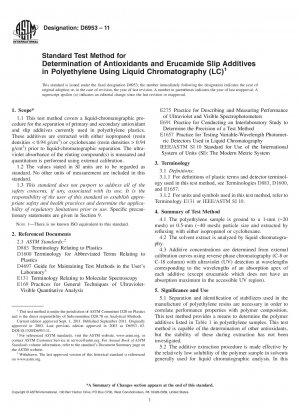ASTM D6953-11
Standard Test Method for Determination of Antioxidants and Erucamide Slip Additives in Polyethylene Using Liquid Chromatography (LC)
- Standard No.
- ASTM D6953-11
- Release Date
- 2011
- Published By
- American Society for Testing and Materials (ASTM)
- Status
- Replace By
- ASTM D6953-18
- Latest
- ASTM D6953-18
- Scope
Separation and identification of stabilizers used in the manufacture of polyethylene resins are necessary in order to correlate performance properties with polymer composition. This test method provides a means to determine the polymer additives listed in Table 1 in polyethylene samples. This test method is capable of the determination of other antioxidants, but the stability of these during extraction has not been investigated.
The additive extraction procedure is made effective by the relatively low solubility of the polymer sample in solvents generally used for liquid chromatographic analysis. In this method, isopropanol and cyclohexane were chosen because of their excellent extraction efficiencies as well as for safety reasons. Other solvents including ethylacetate, isobutanol, chloroform and methylene chloride can also be used.
Methods other than refluxing that have been used to remove additives from the polymer matrix including pressurized liquid, microwave, ultrasonic, and supercritical fluid extractions. For the separation of the extracted additives, SFC and GC have been used successfully for several of the additives.
Under optimum conditions, the lowest level of detection for an antioxidant is approximately 2 ppm.
1.1 This test method covers a liquid-chromatographic procedure for the separation of primary and secondary antioxidant and slip additives currently used in polyethylene plastics. These additives are extracted with either isopropanol (resin densities < 0.94 g/cm3) or cyclohexane (resin densities > 0.94 g/cm3) prior to liquid-chromatographic separation. The ultraviolet absorbance of the eluting compound(s) is measured and quantitation is performed using external calibration.
1.2 The values stated in SI units are to be regarded as standard. No other units of measurement are included in this standard.
1.3 This standard does not purport to address all of the safety concerns, if any, associated with its use. It is the responsibility of the user of this standard to establish appropriate safety and health practices and determine the applicability of regulatory limitations prior to use. Specific precautionary statements are given in Section 9.
Note 18212;There is no known ISO equivalent to this standard.
ASTM D6953-11 Referenced Document
- ASTM D1600 Standard Terminology for Abbreviated Terms Relating to Plastics
- ASTM D4697 Standard Guide for Maintaining Test Methods in the User's Laboratory
- ASTM D883 Standard Terminology Relating to Plastics
- ASTM E131 Standard Definitions of Terms and Symbols Relating to Molecular Spectroscopy
- ASTM E1657 Standard Practice for Testing Variable-Wavelength Photometric Detectors Used in Liquid Chromatography
- ASTM E169 Standard Practices for General Techniques of Ultraviolet-Visible Quantitative Analysis
- ASTM E275 Standard Practice for Describing and Measuring Performance of Ultraviolet, Visible, and Near-Infrared Spectrophotometers
- ASTM E691 Standard Practice for Conducting an Interlaboratory Study to Determine the Precision of a Test Method
- IEEE/ASTM SI 10 American National Standard for Metric Practice
ASTM D6953-11 history
- 2018 ASTM D6953-18 Standard Test Method for Determination of Antioxidants and Erucamide Slip Additives in Polyethylene Using Liquid Chromatography (LC)
- 2011 ASTM D6953-11 Standard Test Method for Determination of Antioxidants and Erucamide Slip Additives in Polyethylene Using Liquid Chromatography (LC)
- 2003 ASTM D6953-03 Standard Test Method for Determination of Antioxidants and Erucamide Slip Additives in Polyethylene Using Liquid Chromatography (LC)
